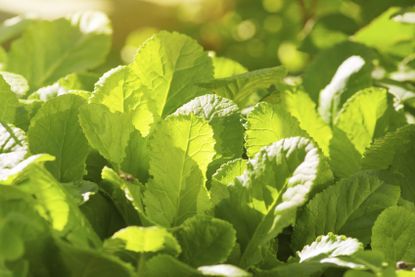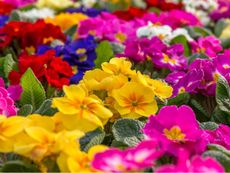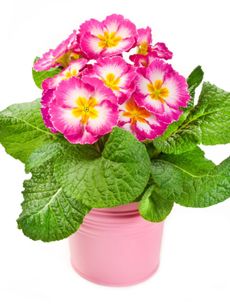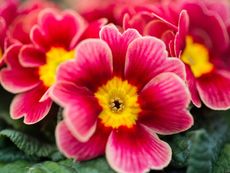Yellowing Primrose Plants: Why Are Primrose Leaves Turning Yellow


Primroses are one of the first bloomers of spring in cold winter climates, and a bright and welcome sign of warm weather to come. Sometimes, however, you may discover what you thought to be healthy primrose leaves turning yellow, which can put a real damper on an otherwise happy celebration of spring. Keep reading to learn how to treat yellow primrose leaves.
Why are Primrose Leaves Turning Yellow?
Yellowing primrose plants can be attributed to a few causes. One common and easily treated problem is improper watering. Primroses need moist but not waterlogged soil. Make sure to water them regularly, but plant them in soil with good drainage to ensure they don’t stand in water, which can cause root rot and yellowing leaves. By the same token, don’t let the soil dry out, as this can cause yellow, brittle leaves. Two exceptions to this basic rule are the Japanese and drumstick primrose, which can both thrive in very wet soil. Leaves may also turn yellow if your plant is in direct sunlight. Primroses can tolerate direct sun in places with very cool summers but, in most cases, it’s best to plant them in partial or filtered sunlight.
Diseases That Cause Yellowing Primrose Plants
Not all causes of yellowing primrose plants are environmental. Various varieties of fungal rot are manifested in the production of smaller leaves that turn yellow and wither quickly. Remove and destroy infected plants to reduce the spread of the rot to healthy plants. Improving drainage may also help combat it. Leaf spot is another disease that appears as yellow to brown spots on the undersides of leaves. Leaf spot can be combatted by the application of fungicides or the simple removal of infected plants or leaves. Mosaic virus can be transmitted by aphids and appears as a yellow mottling on leaves that are often very stunted. The virus is not serious but is easily spread, so remove and destroy infected plants to prevent further infestation.
Gardening tips, videos, info and more delivered right to your inbox!
Sign up for the Gardening Know How newsletter today and receive a free download of our most popular eBook "How to Grow Delicious Tomatoes."

The only child of a horticulturist and an English teacher, Liz Baessler was destined to become a gardening editor. She has been with Gardening Know how since 2015, and a Senior Editor since 2020. She holds a BA in English from Brandeis University and an MA in English from the University of Geneva, Switzerland. After years of gardening in containers and community garden plots, she finally has a backyard of her own, which she is systematically filling with vegetables and flowers.
-
 Urban Beekeeping Guide: Top Tips For Raising Bees In The City
Urban Beekeeping Guide: Top Tips For Raising Bees In The CityUrban beekeeping can be a rewarding and appreciated pastime, but first be sure it’s legal in your city and learn the ropes of beekeeping.
By Mary Ellen Ellis
-
 2024 Plant Of The Year: Why Experts Say Philodendron Is The “It” Plant Of The Year
2024 Plant Of The Year: Why Experts Say Philodendron Is The “It” Plant Of The YearWe aren’t surprised that philodendron was designated the plant of the year. Versatile, easy-care and lovely, it’s the houseplant of the year 2024!
By Bonnie L. Grant
-
 Primrose Plant Problems: Common Diseases And Pests Of Primula
Primrose Plant Problems: Common Diseases And Pests Of PrimulaProper planting and culture can prevent many primula plant problems, but it is a good idea to become familiar with some of the diseases and pests of primula. This article provides more information on common problems with primroses.
By Tanya Hein
-
 German Primula Info: Tips On Caring For Primula Obonica Plants
German Primula Info: Tips On Caring For Primula Obonica PlantsGerman primrose plants produce beautiful blooms in a wide variety of colors for many months at a time, and can be very rewarding to grow. Click this article for more German primula information and try your hand at growing them.
By Liz Baessler
-
 Growing Primroses Indoors: Tips For Primrose Indoor Care
Growing Primroses Indoors: Tips For Primrose Indoor CareThe cheery flowers on primroses can chase away wintera??s dreariness, but they also leave many owners asking how to grow primrose indoors. Primrose indoor care is important, and this article will help.
By Heather Rhoades
-
 Growing Primrose - Primrose Plants In Your Garden
Growing Primrose - Primrose Plants In Your GardenPrimrose flowers bloom in early spring, offering a variety of form, size, and color. They are suitable for use in garden beds, borders and containers. Get growing and care information for primrose here.
By Nikki Tilley